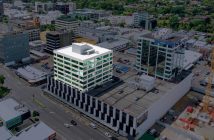Conversations with Mike Neale of Nai Harcourts Hamilton
Seismic ratings for commercial and industrial buildings are becoming increasingly important for both building owners and tenants – and also those with other financial interests in the buildings, such as banks and insurance companies.
What are the legislative requirements? In 2018 the government introduced legislation for building owners to ensure the percentage of New Building Standard (NBS) is above 33% of the current building code.
Seismic Rating Grades
A Grade 80% – 100% NBS
B Grade 67% – 79% NBS
C Grade 34% – 66% NBS
D Grade 20% – 33% NBS
E Grade <20% NBS

Mike Neale – Managing Director,
NAI Harcourts Hamilton.
Many factors affect a building’s seismic performance, including the age of the building, soil type, pounding effect from neighbouring buildings, ductility of the structure, building importance level, critical structural weaknesses etc.
Currently, Hamilton buildings have 25 years meet this requirement and to strengthen or demolish if required, although council is currently undertaking a process to determine which buildings are Priority Buildings. Priority Buildings will only have 12.5 years to meet the required standard.
Depending on the geographic location within New Zealand, and the use of the building within that geographic location, the timeframes to meet this minimum requirement vary.
Different areas of New Zealand are classified according to the seismic risk (their Z factor), which impacts their required structural performance. For example, a building in Wellington is required to be built to a much higher engineering standard than one in Whangarei, due to the Z factor risk associated with their location – even though both buildings may have the same NBS percentage.
High Risk Areas – Wellington, Christchurch, Napier, Hastings
Medium Risk Areas – Tauranga, New Plymouth, Hamilton
Low Risk Areas – Auckland, Northland, Dunedin
Note: Hamilton is at the low end of the Medium Risk category
What are tenants seeking? While the legislative requirement is to only be 34% NBS or higher, many corporate tenants are seeking 67% NBS or higher. Government however has set the bar much higher, with 80% NBS for existing buildings and (obviously) 100% NBS for new buildings.
Anecdotally, most local or independent businesses appear satisfied that a building meets the minimum standard of 34% NBS, or when it is below this, seem to understand that there is a defined legislative timeframe to meet this standard.
Different types of seismic assessment
Initial Seismic Assessment (ISA) – provides a relatively quick, high level and qualitative measure of a building’s performance.
Detailed Seismic Assessment (DSA) – provides a more reliable result and, should a building require strengthening, will also identify features to be addressed – canopy, stairs, beam connections, critical structural weaknesses etc.
In my experience, we have found that in a number of instances an ISA has provided a more conservative result, and only upon completion of a further DSA has the true (superior) result been provided.
When will you need a seismic assessment?
If you are selling. This is one of the first things that a potential purchaser’s financier or bank will ask for. Without a report, then it’s almost certain that they will be unable to borrow against the property, so you will likely eliminate the majority of potential purchasers.
If you are leasing. This is a question that is being increasingly asked by potential tenants.
Insurance. This can affect both the landlord’s building insurance and also a tenant’s own business insurance.
Body corporates. With multi-unit ownership and the fact that this is becoming an increasingly common form of ownership, it is surprising the number of body corporates that have not been proactive in undertaking seismic reports as a matter of course, for the benefit of the unit owners. It’s a single cost that can usually be spread between all the various unit owners, as opposed to each unit owner getting their own report.
My last piece of advice – talk to a suitably qualified engineering company in terms of the costs, time frame for completion and their experience with the type of building you own. Some buildings are more straightforward than others and in many instances Hamilton City Council may hold engineering plans, which can often provide a more accurate and faster result.
In a fast-moving market, both from a sale and purchase perspective and leasing market for tenants, it is important to understand that it can often take an extended period of time to have a report undertaken, especially when a DSA is required. Several recent instances that we have been involved in have taken months to be completed. So, if you are considering the possibility of selling or have a vacancy looming, now may be the time to get on to this.





